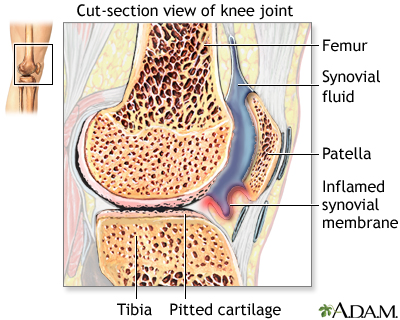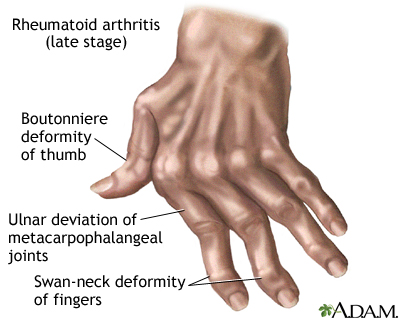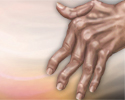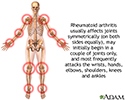Rheumatoid arthritis
RA; Arthritis - rheumatoid
Rheumatoid arthritis (RA) is a long-term disease. It leads to inflammation of the joints and surrounding tissues. It can also affect other organs.
Causes
The cause of RA is unknown. It is an autoimmune disease. This means the body's immune system mistakenly attacks healthy tissue.
RA can occur at any age, but is more common in middle age. Women get RA more often than men.
Infection, genes, and hormone changes may be linked to the disease. Smoking may also be linked to RA.
It is much less common than osteoarthritis, which is a condition that occurs in many people due to wear and tear on the joints as they age.
Symptoms
Most of the time, RA affects joints on both sides of the body equally. Wrists, fingers, knees, feet, and ankles are the most commonly affected.
The disease often begins slowly. Early symptoms may include minor joint pain, stiffness, and fatigue.
Joint symptoms may include:
- Morning stiffness, which lasts more than 1 hour, is common. Joints may feel warm, tender, and stiff when not used for an hour.
- Joint pain is often felt in the same joint on both sides of the body. The joints are often swollen.
- Over time, joints may lose their range of motion and may become deformed.
Other symptoms include:
- Chest pain when taking a breath (pleurisy)
- Dry eyes and mouth (Sjogren syndrome)
-
Eye burning, itching, and discharge
Eye burning, itching, and discharge
Eye burning with discharge is burning, itching, or drainage from the eye of any substance other than tears.
 ImageRead Article Now Book Mark Article
ImageRead Article Now Book Mark Article -
Nodules
under the skin (most often a sign of more severe disease)
Nodules
Skin nodules are solid or cystic raised bumps in the skin that are wider than 1 centimeter (cm), but less than 2 cm.
 ImageRead Article Now Book Mark Article
ImageRead Article Now Book Mark Article - Numbness, tingling, or burning in the hands and feet
- Sleep difficulties
Exams and Tests
There is no test that can determine for sure whether you have RA. Most people with RA will have some abnormal test results. However, some people will have normal results for all tests.
Two lab tests that often help in the diagnosis are:
-
Rheumatoid factor
Rheumatoid factor
Rheumatoid factor (RF) is a blood test that measures the amount of the RF antibody in the blood.
 ImageRead Article Now Book Mark Article
ImageRead Article Now Book Mark Article - Anti-CCP antibody
Other tests that may be done include:
-
Complete blood count
Complete blood count
A complete blood count (CBC) test measures the following:The number of red blood cells (RBC count)The number of white blood cells (WBC count)The tota...
 ImageRead Article Now Book Mark Article
ImageRead Article Now Book Mark Article - C-reactive protein
-
Erythrocyte sedimentation rate
Erythrocyte sedimentation rate
ESR stands for erythrocyte sedimentation rate. It is commonly called a "sed rate. "It is a test that indirectly measures how much inflammation is in...
Read Article Now Book Mark Article -
Joint x-rays
Joint x-rays
This test is an x-ray of a knee, shoulder, hip, wrist, ankle, or other joint.
Read Article Now Book Mark Article -
Joint
ultrasound
or
MRI
Ultrasound
Ultrasound uses high-frequency sound waves to make images of organs and structures inside the body.
 ImageRead Article Now Book Mark Article
ImageRead Article Now Book Mark ArticleMRI
A magnetic resonance imaging (MRI) scan is an imaging test that uses powerful magnets and radio waves to create pictures of the body. It does not us...
 ImageRead Article Now Book Mark Article
ImageRead Article Now Book Mark Article -
Joint fluid analysis
Joint fluid analysis
Synovial fluid analysis is a group of tests that examine joint (synovial) fluid. The tests help diagnose and treat joint-related problems.
 ImageRead Article Now Book Mark Article
ImageRead Article Now Book Mark Article
Treatment
RA most often requires long-term treatment. Treatment includes medicines, physical therapy, exercise, education, and possibly surgery. Early, aggressive treatment for RA with newer drug categories can be very helpful to slow joint destruction and prevent deformities.
MEDICINES
Disease modifying antirheumatic drugs (DMARDs): These are often the drugs that are tried first in people with RA. They are prescribed along with rest, strengthening exercise, and anti-inflammatory drugs.
- Methotrexate is the most commonly used DMARD for rheumatoid arthritis. Leflunomide and hydroxychloroquine may also be used.
- Sulfasalazine is a drug that is often combined with methotrexate and hydroxychloroquine (triple therapy).
- It may be weeks or months before you see any benefit from these drugs.
- These drugs may have serious side effects, so you will need frequent blood tests when taking them.
Anti-inflammatory medicines: These include aspirin and nonsteroidal anti-inflammatory drugs (NSAIDs), such as ibuprofen, naproxen and celecoxib.
- These drugs work well to reduce pain and swelling. Long-term use can cause stomach problems, including ulcers and bleeding, and possible heart problems.
- Since they do not prevent joint damage if used alone, DMARDS should be used as well.
Antimalarial medicines: This group of medicines includes hydroxychloroquine (Plaquenil). They are most often used along with methotrexate. It may be weeks or months before you see any benefit from these drugs.
Corticosteroids: These medicines work very well to reduce joint swelling and inflammation, but they can have long-term side effects. Therefore, they should be taken only for a short time and in low doses when possible.
Biologic agents: These drugs are designed to affect parts of the immune system that play a role in the disease process of rheumatoid arthritis.
They may be given when other medicines for rheumatoid arthritis have not worked. Sometimes biologic drugs are started sooner, along with other rheumatoid arthritis drugs. However, because they are very expensive, insurance approval is generally required.
Most of them are given either under the skin or into a vein There are different types of biologic agents.
Biologic agents can be very helpful in treating rheumatoid arthritis. However, people taking these drugs must be watched very closely because of serious risk factors:
- Infections from bacteria, viruses, and fungi
-
Leukemia
or lymphoma
Leukemia
Leukemia is a type of blood cancer that begins in the bone marrow. Bone marrow is the soft tissue in the center of the bones, where blood cells are ...
 ImageRead Article Now Book Mark Article
ImageRead Article Now Book Mark Article -
Psoriasis
Psoriasis
Psoriasis is a skin condition that causes skin redness and irritation. Most people with psoriasis have thick, red skin with flaky, silver-white patc...
 ImageRead Article Now Book Mark Article
ImageRead Article Now Book Mark Article - Allergic reactions
SURGERY
Surgery may be needed to correct severely damaged joints. Surgery may include:
- Removal of the joint lining (synovectomy)
-
Total joint replacement in extreme cases: may include
total knee replacement
,
hip replacement
, ankle replacement, shoulder replacement, and others
Total knee replacement
Knee joint replacement is a surgery to replace a knee joint with a man-made joint. The artificial joint is called a prosthesis.
 ImageRead Article Now Book Mark Article
ImageRead Article Now Book Mark ArticleHip replacement
Hip joint replacement is surgery to replace all or part of the hip joint with a man-made joint. The artificial joint is called a prosthesis....
 ImageRead Article Now Book Mark Article
ImageRead Article Now Book Mark Article
PHYSICAL THERAPY
Range-of-motion exercises and exercise programs prescribed by a physical therapist can delay the loss of joint function and help keep muscles strong.
Sometimes, therapists will use special machines to apply deep heat or electrical stimulation to reduce pain and improve joint movement.
Other therapies that may help ease joint pain include:
- Joint protection techniques
- Heat and cold treatments
- Splints or orthotic devices to support and align joints
- Frequent rest periods between activities, as well as 8 to 10 hours of sleep per night
NUTRITION
Some people with RA may have intolerance or allergies to certain foods. A balanced nutritious diet is recommended. It may be helpful to eat foods rich in fish oils (omega-3 fatty acids). Smoking cigarettes should be stopped. Excessive alcohol should also be avoided.
Support Groups
Some people may benefit from taking part in an arthritis support group .
Arthritis support group
The following organizations provide more information on arthritis:American Academy of Orthopaedic Surgeons -- orthoinfo. aaos. org/menus/arthritis. c...

Outlook (Prognosis)
How well a person does depends on the severity of symptoms and the response to treatment. It is very important to have regular return visits to the provider, who will adjust treatment to control the arthritis.
Permanent joint damage may occur without proper treatment. Early treatment with a three-drug DMARD combination known as "triple therapy," or with the biologic drugs, can decrease joint pain and damage. These drugs are given by specialists called rheumatologists.
Possible Complications
If not well treated, rheumatoid arthritis can affect nearly every part of the body. Complications may include:
-
Damage to the lung tissue (
rheumatoid lung
)
Rheumatoid lung
Rheumatoid lung disease is a group of lung problems related to rheumatoid arthritis. The condition can include:Blockage of the small airways (bronch...
 ImageRead Article Now Book Mark Article
ImageRead Article Now Book Mark Article - Increased risk of hardening of the arteries
- Spinal injury when the neck bones become damaged
- Inflammation of the blood vessels (rheumatoid vasculitis), which can lead to skin, nerve, heart, and brain problems
-
Swelling and inflammation of the outer lining of the heart (
pericarditis
) and of the heart muscle (
myocarditis
), which can lead to
congestive heart failure
Pericarditis
Pericarditis is a condition in which the sac-like covering around the heart (pericardium) becomes inflamed.
 ImageRead Article Now Book Mark Article
ImageRead Article Now Book Mark ArticleMyocarditis
Myocarditis is inflammation of the heart muscle. The condition is called pediatric myocarditis when it occurs in children.
 ImageRead Article Now Book Mark Article
ImageRead Article Now Book Mark ArticleCongestive heart failure
Heart failure is a condition in which the heart is no longer able to pump oxygen-rich blood to the rest of the body efficiently. This causes symptom...
 ImageRead Article Now Book Mark Article
ImageRead Article Now Book Mark Article
However, these complications can most often be avoided with proper treatment. The treatments for RA can also cause serious side effects. Talk to your health care provider about the possible side effects of treatment and what to do if they occur.
When to Contact a Medical Professional
Call your health care provider if you think you have symptoms of rheumatoid arthritis.
Prevention
There is no known prevention. Smoking cigarettes appears to worsen RA, so it is important to avoid tobacco. Proper early treatment can help prevent further joint damage.
References
Mason JC. Rheumatic diseases and the cardiovascular system. In: Mann DL, Zipes DP, Libby P, Bonow RO, Braunwald E, eds. Braunwald's Heart Disease: A Textbook of Cardiovascular Medicine. 10th ed. Philadelphia, PA: Elsevier Saunders; 2015:chap 84.
McInnes IB, Schett G. The pathogenesis of rheumatoid arthritis. N Engl J Med. 2011;365:2205-2219. PMID: 22150039 www.ncbi.nlm.nih.gov/pubmed/22150039 .
O'Dell JR. Rheumatoid arthritis. In: Goldman L, Schafer AI, eds. Goldman's Cecil Medicine. 25th ed. Philadelphia, PA: Elsevier Saunders; 2016:chap 264.
O'Dell JR, Mikuls TR, Taylor TH, et al. Therapies for active rheumatoid arthritis after methotrexate failure.
N Engl J Med.
2013;369:307. PMID: 23755969
www.ncbi.nlm.nih.gov/pubmed/23755969
.
Singh JA, Saag KG, Bridges SL, et al. 2015 American College of Rheumatology guideline for the treatment of rheumatoid arthritis.
Arthritis Rheumatol.
2016;68(1):1-26. PMID: 26545940
www.ncbi.nlm.nih.gov/pubmed/26545940
.
Sweeney SE, Harris ED, Firestein GS. Clinical features of rheumatoid arthritis. In: Firestein GS, Budd RC, Gabriel SE, McInnes IB, O'Dell JR, eds.
Kelley's Textbook of Rheumatology.
9th ed. Philadelphia, PA: Elsevier Saunders; 2013:chap 70.
-
Rheumatoid arthritis
Animation
-
Rheumatoid arthritis - illustration
Rheumatoid arthritis is an autoimmune disease in which the body's immune system attacks itself. The pattern of joints affected is usually symmetrical, involves the hands and other joints and is worse in the morning. Rheumatoid arthritis is also a systemic disease, involving other body organs, whereas osteoarthritis is limited to the joints. Over time, both forms of arthritis can be crippling.
Rheumatoid arthritis
illustration
-
Rheumatoid arthritis - illustration
The affect of rheumatoid arthritis can progress to the degree that it is crippling. Deformities distinctive to late-stage rheumatoid arthritis such as ulnar deviation of the bones of the hands, or swan-neck deviation of the fingers occur because muscles and tendons on one side of the joint may overpower those on the other side, pulling the bones out of alignment.
Rheumatoid arthritis
illustration
-
Rheumatoid arthritis - illustration
Rheumatoid arthritis is another form of arthritis. The body’s own immune system attacks a joint’s synovial membrane, which secretes fluid and lines the joint. The synovium becomes inflamed, produces excess fluid, and the cartilage becomes rough and pitted.
Rheumatoid arthritis
illustration
-
Rheumatoid arthritis - illustration
Rheumatoid arthritis is an autoimmune disease in which the body's immune system attacks itself. The pattern of joints affected is usually symmetrical, involves the hands and other joints and is worse in the morning. Rheumatoid arthritis is also a systemic disease, involving other body organs, whereas osteoarthritis is limited to the joints. Over time, both forms of arthritis can be crippling.
Rheumatoid arthritis
illustration
-
Rheumatoid arthritis - illustration
The affect of rheumatoid arthritis can progress to the degree that it is crippling. Deformities distinctive to late-stage rheumatoid arthritis such as ulnar deviation of the bones of the hands, or swan-neck deviation of the fingers occur because muscles and tendons on one side of the joint may overpower those on the other side, pulling the bones out of alignment.
Rheumatoid arthritis
illustration
-
Rheumatoid arthritis - illustration
Rheumatoid arthritis is another form of arthritis. The body’s own immune system attacks a joint’s synovial membrane, which secretes fluid and lines the joint. The synovium becomes inflamed, produces excess fluid, and the cartilage becomes rough and pitted.
Rheumatoid arthritis
illustration
-
Rheumatoid arthritis
(In-Depth)
-
Rheumatoid arthritis
(Alt. Medicine)
Review Date: 1/16/2016
Reviewed By: Gordon A. Starkebaum, MD, Professor of Medicine, Division of Rheumatology, University of Washington School of Medicine, Seattle, WA. Also reviewed by David Zieve, MD, MHA, Isla Ogilvie, PhD, and the A.D.A.M. Editorial team.






